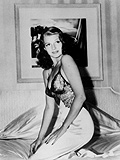Previous NPR Coverage |
|
 |
In 1983, NPR's Susan Stamberg interviewed screenwriter Art Kean about a TV movie on Rita Hayworth. |
 |
Rita Hayworth died on May 14, 1987. NPR Film Critic Bob Mondello remembered Hayworth with a commentary. |
 |
Rita Hayworth
 Listen to Susan Stamberg's report. Listen to Susan Stamberg's report.
 The main character in Nicholas Christopher's Franklin Flyer meets Rita Hayworth. Read an excerpt. The main character in Nicholas Christopher's Franklin Flyer meets Rita Hayworth. Read an excerpt.
|
May 13, 2002 --
In the summer of 1941, just a few months before Pearl Harbor was attacked, LIFE magazine ran a black-and-white photograph of an up-and-coming movie actress named Rita Hayworth. In the photo, the redheaded beauty is kneeling on a bed made up with satin sheets. Her silky nightgown is white, with black lace trimming the low-cut top. She's smiling slightly for photographer Bob Landry.
The snapshot would become one of the most popular pin-ups of World War II, as NPR's Susan Stamberg reports for Morning Edition's Present at the Creation series.
Hayworth was one of the biggest stars of Hollywood's Golden Age. Her biggest success on film was the lead role in Gilda. "There NEVER was a woman like Gilda!" says a movie poster of the day. She made dozens of others in a career cut short by the onset of illness.
It was during the filming of You'll Never Get Rich that the 1941 silk-and-lace LIFE magazine photo was taken.
LIFE magazine was crucial to the moviemakers. Pictures in the magazine brought people to the movie houses. John Morris, who began working in LIFE's Beverly Hills office shortly after the photo was taken, says each of the big studios had an individual press agent specifically assigned to the magazine.
At Columbia Pictures, where Hayworth was under contract, the press agent lobbied LIFE to run photos of the glamorous 23-year-old dancer-actress.
Photographer Bob Landry showed up with his camera. The details surrounding the photo shoot are unclear. One story has it that the photo was taken in Hayworth's own bedroom, but another suggests that she knelt on a bed on the movie set. The sexy lace nightie was either made by the press agent's mother or came from Columbia Pictures' prop department. A flashbulb may or may not have failed -- sculpting the shadow on Hayworth's chest. One rumor has it that someone told Hayworth to take a deep breath before the famous shot, making the image even more provocative.
The details are fuzzy, but the image made that day became a cultural icon, even if it wasn't a cover shot.
"I think the editors of LIFE would have considered it too risqué for the cover," says LIFE photo editor John Morris. "It was OK inside. Was it the talk of the office? I mean, did people know what a phenomenon this photograph was going to be? No, not at all. It had run in the magazine and we were working on the next issue."
Four months after Hayworth's photo was published, America went to war. And soldiers took the silk-and-lace picture along to remind them of home.
By the end of the war, more than 5 million copies of the photo were sold. Only Betty Grable, smiling cutely over her shoulder in a white bathing suit and heels, with legs that went on forever, sold more pin-ups.
Amy Henderson, a cultural historian at the Smithsonian's National Portrait Gallery, sees a real difference in the Hayworth and Grable pin-ups. Grable, she says, had a girl-next-door perkiness about her, while Hayworth was more alluring.
Although she came to be known as "The Love Goddess," Hayworth was shy and even introverted. Nicholas Christopher, who's written about Hayworth in several books, including the new novel Franklin Flyer, sees Hayworth's sweetness in the silk-and-lace picture.
"I think I've always been fascinated by her exoticism and the fact that she seemed very timeless," he says.
Hayworth made her last movie in 1972. She had always been a consummate professional, but on the set of The Wrath of God, she had trouble remembering her lines.
She was diagnosed with Alzheimer's disease, and died 15 years later, at the age of 68.
In her last years, Hayworth's star quality helped bring public attention to what was then still a little-known disorder.
Upon her death May 14, 1987, President Reagan -- not yet diagnosed himself -- praised her work in bringing Alzheimer's disease into the spotlight.
She told one interviewer, "whatever you write about me, don't make it sad."
Other Resources
• Read more about Rita Hayworth.
• See more photos of Rita Hayworth.
• The Internet Movie Database has a filmography of Rita Hayworth.
• Read The New York Times' obituary of Rita Hayworth.
• Read more about photographer Bob Landry and picture editor John Morris.
• Read a review of Hayworth's film Gilda.
The snapshot would become one of the most popular pin-ups of World War II, as NPR's Susan Stamberg reports for Morning Edition's Present at the Creation series.
Hayworth was one of the biggest stars of Hollywood's Golden Age. Her biggest success on film was the lead role in Gilda. "There NEVER was a woman like Gilda!" says a movie poster of the day. She made dozens of others in a career cut short by the onset of illness.
It was during the filming of You'll Never Get Rich that the 1941 silk-and-lace LIFE magazine photo was taken.
LIFE magazine was crucial to the moviemakers. Pictures in the magazine brought people to the movie houses. John Morris, who began working in LIFE's Beverly Hills office shortly after the photo was taken, says each of the big studios had an individual press agent specifically assigned to the magazine.
At Columbia Pictures, where Hayworth was under contract, the press agent lobbied LIFE to run photos of the glamorous 23-year-old dancer-actress.
Photographer Bob Landry showed up with his camera. The details surrounding the photo shoot are unclear. One story has it that the photo was taken in Hayworth's own bedroom, but another suggests that she knelt on a bed on the movie set. The sexy lace nightie was either made by the press agent's mother or came from Columbia Pictures' prop department. A flashbulb may or may not have failed -- sculpting the shadow on Hayworth's chest. One rumor has it that someone told Hayworth to take a deep breath before the famous shot, making the image even more provocative.
The details are fuzzy, but the image made that day became a cultural icon, even if it wasn't a cover shot.
"I think the editors of LIFE would have considered it too risqué for the cover," says LIFE photo editor John Morris. "It was OK inside. Was it the talk of the office? I mean, did people know what a phenomenon this photograph was going to be? No, not at all. It had run in the magazine and we were working on the next issue."
Four months after Hayworth's photo was published, America went to war. And soldiers took the silk-and-lace picture along to remind them of home.
By the end of the war, more than 5 million copies of the photo were sold. Only Betty Grable, smiling cutely over her shoulder in a white bathing suit and heels, with legs that went on forever, sold more pin-ups.
Amy Henderson, a cultural historian at the Smithsonian's National Portrait Gallery, sees a real difference in the Hayworth and Grable pin-ups. Grable, she says, had a girl-next-door perkiness about her, while Hayworth was more alluring.
Although she came to be known as "The Love Goddess," Hayworth was shy and even introverted. Nicholas Christopher, who's written about Hayworth in several books, including the new novel Franklin Flyer, sees Hayworth's sweetness in the silk-and-lace picture.
"I think I've always been fascinated by her exoticism and the fact that she seemed very timeless," he says.
Hayworth made her last movie in 1972. She had always been a consummate professional, but on the set of The Wrath of God, she had trouble remembering her lines.
She was diagnosed with Alzheimer's disease, and died 15 years later, at the age of 68.
In her last years, Hayworth's star quality helped bring public attention to what was then still a little-known disorder.
Upon her death May 14, 1987, President Reagan -- not yet diagnosed himself -- praised her work in bringing Alzheimer's disease into the spotlight.
She told one interviewer, "whatever you write about me, don't make it sad."
Other Resources
• Read more about Rita Hayworth.
• See more photos of Rita Hayworth.
• The Internet Movie Database has a filmography of Rita Hayworth.
• Read The New York Times' obituary of Rita Hayworth.
• Read more about photographer Bob Landry and picture editor John Morris.
• Read a review of Hayworth's film Gilda.


Rita Hayworth pin-up
Photo: Bob Landry/TIMEPIX
View enlargement.
 Hayworth appears in a 1942 photo encouraging conservation of metal parts for the war effort.
Hayworth appears in a 1942 photo encouraging conservation of metal parts for the war effort.Photo: National Archives
View enlargement.
 Rita Hayworth starred in the film Gilda.
Rita Hayworth starred in the film Gilda. Photo: Columbia Pictures
View enlargement.